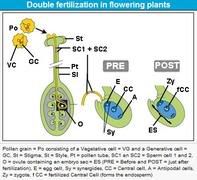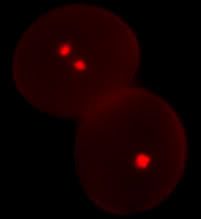Scientists unlock mystery of 'double fertilization'
 An enigma – unique to flowering plants – has been solved by researchers from the University of Leicester (UK) and POSTECH, South Korea. The have learned how 'double fertilization' exactly works. The discovery will be reported in the journal Nature on 23 October 2008.
An enigma – unique to flowering plants – has been solved by researchers from the University of Leicester (UK) and POSTECH, South Korea. The have learned how 'double fertilization' exactly works. The discovery will be reported in the journal Nature on 23 October 2008.Scientists already knew that flowering plants, unlike animals require not one, but two sperm cells for successful fertilisation.
The mystery of this double fertilization process was how each single pollen grain could produce ‘twin’ sperm cells. One to join with the egg cell to produce the embryo, and the other to join with a second cell in the ovary to produce the endosperm, a nutrient-rich tissue, inside the seed.
Double fertilisation is essential for fertility and seed production in flowering plants so increased understanding of the process is important.
Now Professor David Twell, of the Department of Biology at the University of Leicester and Professor Hong Gil Nam of POSTECH, South Korea report the discovery of a gene that has a critical role in allowing precursor reproductive cells to divide to form twin sperm cells.
The key discovery is that this gene, known as FBL17, is required to trigger the destruction of another protein that inhibits cell division. The FBL17 gene therefore acts as a switch within the young pollen grain to trigger precursor cells to divide into twin sperm cells.
Plants with a mutated version of this gene produce pollen grains with a single sperm cell instead of the pair of sperm that are required for successful double fertilization.
Interestingly, the process employed by plants to control sperm cell reproduction was found to make use of an ancient mechanism found in yeast and in animals involving the selective destruction of inhibitor proteins that otherwise block the path to cell division:
 energy :: sustainability :: biomass :: bioenergy :: agriculture :: plant biology :: pollination :: fertilization :: angiosperm :: plant breeding :: climate change ::
energy :: sustainability :: biomass :: bioenergy :: agriculture :: plant biology :: pollination :: fertilization :: angiosperm :: plant breeding :: climate change ::  Removal of these blocks promotes the production of a twin sperm cell cargo in each pollen grain and thus ensures successful reproduction in flowering plants.
Removal of these blocks promotes the production of a twin sperm cell cargo in each pollen grain and thus ensures successful reproduction in flowering plants.This discovery is a significant step forward in uncovering the mysteries of flowering plant reproduction. This new knowledge will be useful in understanding the evolutionary origins of flowering plant reproduction and may be used by plant breeders to control crossing behaviour in crop plants.
In the future such information may become increasingly important as we strive to breed superior crops that maintain yield in a changing climate. Given that flowering plants dominate the vegetation of our planet and that we are bound to them for our survival, it is heartening that we are one step closer to understanding their reproductive secrets. - Professor David TwellResearchers at the University of Leicester are continuing their investigation into plant reproduction. Further research underway in Professor Twell’s laboratory is already beginning to reveal the answers to secrets about how the pair of sperm cells produced within each pollen grain aquires the ability to fertilize.
Prof Twell’s work, in the Department of Biology at the University of Leicester is financially supported by the UK Biotechnology and Biological Research Council (BBSRC).
Image 1: the mechanism of double fertilization. Credit: Lidwien van der Horst, Radboud University, Nijmegen.
Image 2: The image shows two pollen grains viewed by fluorescence microscopy. A pair of red sperm cells are visible in the normal pollen grain (top left) whilst only one red germ cell is present in mutant pollen (bottom right). The sperm cells are visualised using the monomeric red fluorescent protein mRFP1 derived from a coral species. Credit: Lynette Brownfield and David Twell, University of Leicester
References:
David Twell and Hong Gil Nam, - no reference online yet.
 --------------
--------------
 Mongabay, a leading resource for news and perspectives on environmental and conservation issues related to the tropics, has launched Tropical Conservation Science - a new, open access academic e-journal. It will cover a wide variety of scientific and social studies on tropical ecosystems, their biodiversity and the threats posed to them.
Mongabay, a leading resource for news and perspectives on environmental and conservation issues related to the tropics, has launched Tropical Conservation Science - a new, open access academic e-journal. It will cover a wide variety of scientific and social studies on tropical ecosystems, their biodiversity and the threats posed to them.









0 Comments:
Post a Comment
Links to this post:
Create a Link
<< Home